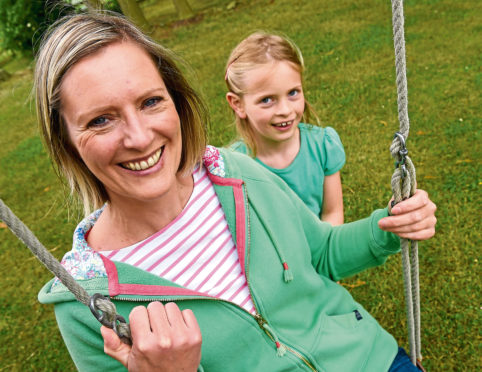It’s hard to believe we are almost into week three of the school holidays already.
Only a few short years ago, I remember stressing about how I was going to amuse Daisy for six or seven weeks.
I’d end up devising a timetable of summer workshops and sports camps – local organisations like Highlife Highland, Aigas Field Centre and Black Isle Youth are all fantastic for their wealth of activities – baking and craft days at home, play dates and day trips until the eagerly anticipated arrival of her London cousins in August, the Black Isle Show and the Game Fair at Moy.
Now I have two energetic girls to entertain yet, ironically, the summer schedule (erm, or rather a certain mum) is a lot more relaxed.
Despite the five-year age gap, the girls get on really well. Most of the time, anyway.
It also works well just now because, when Daisy craves the company of her buddies, happily Mollie is still young enough to enjoy pottering about with me while her older sis goes off to gymnastics or to play with a friend.
And, instead of worrying about what we’re going to do all summer, I relish the time I have with them and am forever grateful that I can work flexibly over the break.
Inherent in farming, Nick’s work schedule is somewhat less flexible, although reliable and dedicated staff along with robotic milking have definitely improved things in the past two years.
Happily for us, Nick now feels confident enough to take a week off in the summer.
Pre-children and pre-robots, we would tend to holiday in September and sometimes January, and we are not long back from an action-packed family staycation.
With such a good team in place at the farm, Nick was relatively relaxed going away this year, albeit we were only three hours away.
The ice cream deliveries and orders were up to date, Scott was on call for the robots and manning the farm at the beginning of the week and Ian was set to take over mid-week.
All sorted – or so Nick thought. Less than 24 hours into the holiday, news came via my father-in-law, Dereck, that poor Scott was in hospital after a road accident.
Thankfully, he wasn’t badly hurt and made a full recovery within a couple of days and luckily Dereck was able to step in and take over the running of Rootfield in the interim.
Nick had been planning to drive home until Ian could relieve him.
This aside, plus a few escapee cows and calves in a neighbour’s garden, things ran smoothly while we were away.
The sporadic super-sunny days have seen a boost in ice cream sales, while the very wet days have taken their toll on parts of the recently repaired farm drive.
On the farm, improved herd fertility has seen a bumper number of calvings this month – predominantly straightforward – and the majority heifers can rejoin the herd.
The male dairy calves are fattened over at my father-in-law’s sheepholding near Inverness for beef.
Meanwhile, Nick is starting to reconsider the place of the Jersey girls among the herd.
With their honey-coloured hides and curly eyelashes, the dinky Jerseys were originally bought in 2012 to help increase the cream content of the milk which goes into all our ice cream and yoghurt.
However, since then Nick has introduced robotic milking at the farm and the Jerseys’ diminutive size and their cheeky personalities make them problematic to milk.
They are less willing to wait for the robot to dish out their food before lining up their sophisticated lasers to attach themselves to their quarters.
Being smaller and more nimble than the Holsteins and Ayrshires, they simply scoff their cake and scoot through before being milked, setting the robot alarms off day and night.
The cattle shed has also been designed with long, deep cubicles for the bigger cows’ comfort backed by a central slurry passage which is scraped twice daily.
However, being a daintier breed, the Jerseys aren’t, well … how to put this … long enough to poop into the slurry channel, which means mucking out more of their beds more often, using more manpower and more sawdust.
Another reason the Jerseys may have fallen out of favour with my fickle farmer more recently is the arrival of the treacle-hued Ayrshires.
Nick bought his first Ayrshire cattle 18 months ago and he has been won over by their couthie nature, robust stature and the all-important gold top factor.
Their milk has a higher butterfat content and, although not quite as big or angular, the Ayrshire cows are closer in size to the original Holstein-Friesians of the herd, which make them a more natural and practical fit for both the cubicles and the robots.
I have to admit that the girls and I would be sad to see the departure of the doe-eyed Jerseys to another dairy. But, from a financial and efficiency perspective, it would be a hard one to argue.
But from a development viewpoint, one thing which might justify the extra resources would be to explore the possibility of creating a premium Jersey milk and or yoghurt and ice cream brand.
That’s something for me to work on after the summer.
Next time: Back to school.
Rootfield Farm is on the Black Isle, 10 miles north of Inverness, where Jo lives with husband Nick, a dairy farmer, their daughters Daisy and Mollie, and 170 cows
